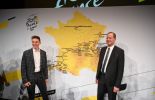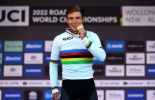2014 Giro d'Italia Preview and Predictions
The 2014 Giro d’Italia will not be a picnic. The race will be 3,449.9 km long and will feature four medium mountain stages with summit finishes and five high mountain stages with summit finishes. It will also have three time trials totaling 94.9 km and eight sprinters’ stages.
The 2014 edition strives to be more humane than previous editions, however. Recent Giri have had riders finishing stages and then having repeated transfers. The 2014 Giro will see fewer transfers and three rest days instead of the customary two. If the stages will be no easier than usual, at least the activities between them will be.
The 2014 Giro d'Italia will begin in Belfast, Northern Ireland with a 21.7-km team time trial. Stage 2 will also take place in and around Belfast, with the riders tackling a somewhat lumpy, 218-km ride. Stage 3 will take the riders from Armagh in Northern Ireland to Dublin in the Irish Republic. The first rest day will follow Stage 3, with the riders being transferred to Italy.
Stage 4, a 121-km run from Giovinazzo to Bari, should end in a sprint, but the following two stages will be medium mountain ones. Stage 5 will be a 200-km ride from Taranto to Viggiano, while Stage 6 will be a 247-km ride from Sassano to Monte Cassino, the monastery that Allied bombs destroyed during the Second World War. Stage 7 will be a 214-km run from Frosinone to Foligno and should end in a sprint, but Stages 8 and 9, a 174-km ride from Foligno to Monte Copiolo and a 174-km ride from Lugo to Sestola, respectively, will be medium mountain rides. The race’s second rest day follows Stage 9.
Stage 10 will be a flat, 184-km run from Modena to Salsomaggiore Terme that a sprinter should win. The road will turn skyward again in Stage 11, the race’s longest stage, a 249-km medium mountain stage from Collechio to Savona. Stage 12 will be the second of the 2014 Giro’s three time trials, a 46.4-km affair from Barbaresco to Barolo that will have a hilly finish. Stage 13 will be a flat, 158-km run from Fossano to Rivarolo Canavese that a sprinter should win.
The race will then move into the high mountains, where it will stay for most of the rest of the race. Stage 14 will be a 162-km ride from Aglie to Oropa that will feature three high mountain passes, including the ascent to the finish. Stage 15 will take the riders 217 km from Valdengo to Plan di Montecampione and will end with a stiff climb. The third rest day will follow Stage 15.
Stage 16 will be another mountain battle. The 139-km ride from Ponte di Legno to Val Martello/Martelltal will go over the Gavia and Stelvio passes before ending with a climb to the finish. The riders will get a break in Stage 17, a mainly flat, 204-km run from Sarnonico to Vittorio Veneto, but in Stage 18, they will tackle three climbs, including the ascent to the finish, during the high mountain, 171-km ride from Belluno to Rif. Panarotta (Valsugana). Stage 19 will be a 26.8-km mountain time trial from Bassano del Grappa to Cima Grappa, and Stage 20 will be the race’s last mountain stage, with the riders taking on three high mountain passes, including the climb to the finish. Stage 21, a flat, 169-km run from Gemona del Friuli to Trieste, will be a procession for the winner.
There is no clear favorite to win the 2014 Giro d'Italia. Joaquim Rodriguez (Katusha) is one of the most obvious favorites to win the race. He has grand tour experience, the course favors him, and the prospect of burnishing his palmares by winning a grand tour motivates the Spaniard. Two things work against him. One is uncertainty about his form, which was good until he crashed twice during the Ardennes classics. The other is Rodriguez’s time trialing, but aside from the team time trial, the courses will suit him better than other time trial courses might.
Nairo Quintana (Movistar) is a strong climber who finished first, second, and fifth, respectively, in the Tour de San Luis, Tirreno-Adriatico, and the Volta a Catalunya. The Giro will be the Colombian’s first chance to ride a grand tour as a team captain. The course suits him, and he will have a strong team to support him. Quintana is a very good bet for the podium.
Another good bet for the podium is Cadel Evans (BMC Racing Team). The Australian finished third last year and has good form, as witnessed by his victory in the Giro del Trentino. He can stay with the best climbers most of the time, and his time trialing might be the best of the GC contenders. He will help his cause if he can attack instead of following other riders’ moves.
Rigoberto Uran (Omega Pharma-Quick Step) finished second last year. He started the race as Bradley Wiggins’s lieutenant at Sky, but took team leadership after the Briton abandoned. Omega Pharma-Quick Step, which is known as a classics squad, has assembled a strong team to support the Colombian in the team time trial and in the mountains. Uran has had a relatively quiet spring, but his fourth place in the Tour de Romandie says that his form is moving in the right direction.
Garmin-Sharp-POC will have co-captains, Ryder Hesjedal and Daniel Martin. Hesjedal won the Giro in 2012, but in 2013 the Canadian battled illness and injury. His spring has been quiet, but Martin’s has not. The Irishman finished second at La Fleche Wallonne and was in second place with 200 m to go when he crashed on the final turn at Liege-Bastogne-Liege. Unless Hesjedal’s form is better than this spring’s results indicate, he will wind up working for Martin, who has the form to make the podium.
Tinkoff-Saxo Bank will also have two GC contenders, Nicolas Roche and Rafal Majka. Roche climbs and time trials well, but his Achilles heel is coping with bad weather. The Irishman can have bad days in wet and cold weather, as he did in the 2013 Vuelta a Espana and the 2014 Tour de Romandie. Roche is likely to see nasty weather in the Dolomites and in the Alps. As for Majka, the Polish all rounder finished seventh in his first Giro last year and fourth in this year’s Criterium International, and his team has high hopes for him.
Two former Giro winners round out the list of potential podium finishers. The first is Michele Scarponi (Astana). Scarponi became the Giro champion in 2011 after Alberto Contador (Tinkoff-Saxo Bank) was stripped of his victory for doping. He still has climbing chops, but other riders, particularly younger ones, can climb as well as or better than the Astana man. Nevertheless, the Italian should be in the lead group on the final climbs of the mountain stages.
Ivan Basso (Cannondale) is a two-time Giro champion. He has had a quiet spring, and his last result in the Giro was his fifth place in 2012. The Italian probably has enough gas in the tank to finish in the top ten, but the podium is optimistic. Like Scarponi, he should be with the best climbers on most of the ascents.
Follow the Giro d'Italia here on www.roadcycling.com beginning Friday, May 9!








